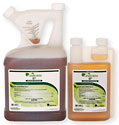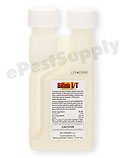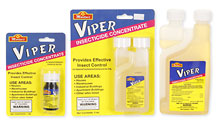The name Pantry Moths are used to describe any moths found in your kitchen and feeding on grains. For the most part, panty moths will fall into two categories: indian meal moths or mediterranean flour moths. The indian meal moth's scientific name is Plodia Interpunctella or P. Interpunctella--Indian Meal Moth. The mediterranean flour moth's scientific name is Ephestia Kuehniella or P. Kuehniella--mediterranean moth or just flour moth.
Life Cycle
As with almost all members of the insect class, panty moths have a life cycle of Eggs, Larvae, Pupa and Adult. Dependent on the circumstances, availablity of food and climate, their life cycle might take as few as 30 days or as long as 300 days. Warmer climates are more conducive to a quicker life cycle.
Eggs: Moth eggs tend to be white gray in color and very small, only measuring 1-2 hundredths of an inch. A mated female moth can lay 400 eggs. She will then drop the eggs on a food source that the larvae will use. The key is the female must find food or there will be no larvae. Pantry Moth eggs usually hatch around 7 days.
Larvae: This is the feeding stage for the pantry moth. Their coloring depends on their food source. The egg produces a worm-like moth larvae about 1/2 inch long and has 5 pair of legs. Usually pantry moths have an of-white coloring, however, their coloring can also be green light pink or even brown. After the larvae have proceeded through five stages of development, their feeding is finished and the larvae use their legs to find a place to develop into a pupa. By now, the food source has been damaged by waste products. The Larvae will develop anywhere from 42 to 56 days.
Pupa: Pantry Moths can be located either in the open or often in spun webbing cocoon. They might go someplace other than the food source to develop, for example crevises of pantry shelves or seams of doorways. They've even been known to spin their cocoon right in their food source! That is why stored foods might have matted web(s). Many times they will be found in a nearby closet around clothing, which can make it easy to confuse them with a clothing moth. The moth pupae are only 1/3 of an inch long and can be as small as 1/4 inch.
Adult: If you see a moth flying around, it is most likely an adult Pantry Moth.The adult pantry moth has only one mission in life: Mate and create more moths! Adult moths are more prone to flying around your house at night and, typically, they are drawn to light and always in search of a mate. The female moth uses her pheromone (scent) to locate and lure the male to find her so she can lay her eggs. Because the adult moth doesn't feed, they usually live only 1 or 2 weeks. Keep in mind, the female is capable of laying up to 400 eggs, so if they die, they've already given birth to a considerable amount that will take her place!
The adult moths is around 1/2 an inch, 5/8" with extended wings. Coloring will differ due to the varying types of moths. The Indian Meal moth's top is a light spotted grey and white with a redish tint on its rear area. The Flour moth tends to change colors from grey and buff white to no hint of color at all. This Adult stage is usually one week to just under two weeks.
There are many types of moths: the Mediterranean Flour, Grain, Miller, Pantry, Seed and Food Moths. The Mediterannean Flour Moth is the short name for E. Kuehniella species. Grain Moth is used because pantry moths are often found in grains from rice, cereal, oatmeal or corn. The Miller Moth is an older term referring to milled grains such as wheat, barley, bean or oatmeal, also referred to as a flour moth. Pantry Moths also known as kitchen moths, cupboard moths, cake moths, bird seed moths, and garage moths. Seed Moths refer to infested bird seeds such as black oil sunflower, nyjer seed, millet and even parrot seeds often are infected by bird seed moths and still fall in the family of Pantry Moths. Food Moths extend to pantry moths found in areas other than food preparation. Examples would include dog or cat food stored in the garage or even stored bird seed. The food it feeds on is irrelevant as it most likely will be our friendly flour or indian meal moth!
How to Prevent & Eliminate Pantry Moths
Home Remedies: Examine EVERYTHING in your panty: Flours, grains, dried fruit, candy, pet food, etc. Be on the lookout for adult moths, larvae, and eggs that may resemble webbing or clumps of grain. Remove any/all infested foods outside and away from your home. To eliminate pantry moths here are the most natural and non-toxic methods we've found and recommend:
Ingredients Needed: Warm, soapy water, White vinegar, essential oil (peppermint, citronella, eucalyptus or tea tree) and Bay leaves
Tools:Vaccum, Cleaning cloth and/or sponge, airtight food storage containers, and freezer
Instructions:
1) Examine EVERYTHING in your panty: Flours, grains, dried fruit, candy, pet food, etc. Be on the lookout for adult moths, larvae, and eggs that may resemble webbing or clumps of grain. Remove any/all infested foods outside and away from your home.
2) Exhaustively clean every nook, cranny, corner, and crevice with a cacuum and/or warm, soapy water and dry completely. If signs of infestations are found, discard trash or vacuum bags oustide and as far away from your home as possible.
3) Wipe shelves, food containers, and surfaces with white vinegar. For additional protection, use a few drops of essential oil like peppermint, citronella, eucalyptus, or tea tree.
4) To prevent further infestation, bay leaves can be used to repel pantry insects. Store foods in air tight glass, metal or plastic containers with bay leaves inside. Bay leaves can also be used in your cupboards.
5) When you bring dry goods home from the store, place them in a plastic bag in the freezer for a week to kill any possible eggs. You can also use the freezer for long-term storage.

Indian Meal Moth
Recommended Indian Meal Moth Remedies:
The Indian Meal Moth, also known as Plodia interpunctella, also spelled Indianmeal Moth, is a pyraloid moth of the family Pyralidae. Other common names are North American High-flyer and Pantry Moth; less specifically, it may be referred to as "flour moth" or "grain moth". The Almond Moth (Cadra cautella) is commonly confused with the Indianmeal Moth.
Its larvae (caterpillars) are commonly known as "waxworms" like those of its relatives, though they are not the particular waxworms often bred as animal food. They are a common grain-feeding pest found around the world, feeding on cereals and similar products.
Adults are 8-10 mm in length with 16-20 mm wingspans. The outer half of their forewings are bronze, copper, or dark gray in color, while the upper half are yellowish-gray, with a dark band at the intersection between the two. The moth larvae are off-white with brown heads. When these larvae mature, they are usually about 12 mm long.
The entire life cycle of this species may take 30 to 300 days. Female moths lay between 60 and 400 eggs on a food surface, which are ordinarily smaller than 0.5 mm and not sticky. The eggs hatch in 2 to 14 days. The larval stage lasts from 2 to 41 weeks, depending on the temperature.
The Indian Meal Moth larvae has been known to infest a wide range of dry foodstuffs of vegetable origin, such as cereal, bread, pasta, rice, couscous, flour, spices or dried fruits and nuts. More unusual recorded foods include chocolate and cocoa beans, coffee substitute, and cookies. The food they infest will often look like they've been webbed together.
Once larvae or moths have been found, it is imperative to throw out all food sources that are not in very tightly sealed containers. The moths are able to get into surprisingly tight spots, including sealed bags simply by chewing through them. They are also notoriously difficult to get rid of, and can crawl on ceilings and spin cocoons in rooms other than the kitchen or pantry where they hatched. Lastly, instar larvae are able to travel significant distances before they pupate. When seeking the source of an infestation, the search cannot be limited to the immediate area where pupae are discovered.
None of the stages of the organism (eggs, larvae, adults) is very temperature-tolerant and all can be killed by a week of freezing or by brief heating in a microwave or conventional oven when such treatment is practical.
Nontoxic traps are also available to inhibit the development of adult moths and precipitate their destruction. For example, one type of trap is a triangular box with a lure inside and sticky walls. These traps are generally known as pheromone traps. In this case male moths are attracted inside by the female pheromone (the lure) and then get stuck against the sticky walls inside of the box.
Moths often do not even need a lure, as common glue traps sometimes work well to reduce the number of adults.
However, the efficiency of such traps is highly doubtful as they only capture males, and usually only a small number of these, while adult females, eggs and larvae are unaffected, enabling a possible reinfestation. Thus it is recommended to first eliminate the source of infestation followed by larvae, eggs and eventual moths in the environment.

Augoumois Grain Moth
Recommended Augomois Grain Moth Sprays:
The Augomois Grain Moth, also referred to as Sitotroga cerealella, is a species of gelechioid moth. It is the type species of its genus Sitotroga, placed in the subfamily Pexicopiinae of the twirler moth family (Gelechiidae). Formerly, it was included in the "Chelariinae", which more recent authors do not separate from the Pexicopiinae and usually even do not consider a distinct tribe ("Chelariini") within them.
It has a nearly global distribution today, including essentially all of Europe as well as such far-flung places as Australia, Benin, Brazil, China, Indonesia, Japan, Samoa and the United States. This is due to its habit of living near and benefitting from humans, which allow it to be easily transported in international grain shipments. Its common name refers to Angoumois, the pre-revolutionary province of France where it was first scientifically described in 1789. The province was transformed into the present-day Charente département the following year, and as it has since been determined, the species is not originally native to western France.
The adults' wingspan is 13–20 mm. Its caterpillars feed on grains of Asian Rice (Oryza sativa), Pearl Millet (Pennisetum glaucum), Sorghum (Sorghum bicolor), wheats (Triticum) and Maize (Zea mays). They bore into the seeds of the host plant and feed inside the seed covering. Consequently, this moth is considered a pest of stored cereals. More unusually, the caterpillars have been recorded to eat other dry plant matter, such as plant specimens stored in herbaria.

Duponchelia Fovealis Moth
Recommended Duponchelia Fovealis Moth Sprays:
The Duponchelia Fovealis Moth is a species of the family Crambidae. It is native to areas around the Mediterranean Sea, and the Canary Islands, but has multiplied its range to other parts of Africa, the Middle East, Europe, and Canada.
The first evidence of Duponchelia fovealis in North America was in California where live larvae were discovered in a shipment of begonias at a Home Depot in Concord, Contra Costa from San Marcos, San Diego. This species was observed in three greenhouses in southern Ontario, Canada around spring of 2005. Four male moths were acquired in a pheromone trap in San Diego County, California approximately July, 2010. If there is an established population at this time we are uncertain.
On 1 November 2010, the USDA-AHIS released a report stating this moth was present in at least 13 U.S. states.
Adult wingspan on the Duponchelia fovealis is approximately 20 mm. This moth takes flight from May to June, depending on their location.
The larvae feed on various plants that include a variety of primarily herbaceous ornamental plants and field crops, for example: Anemone, Anthurium, Begonia, Cyclamen, Euphorbia, Gerbera, Kalanchoe, Limonium, Rosa, certain aquatic plants, corn, cucumbers, peppers, pomegranate, tomatoes, and certain herbs.

Cydia Pomonella Moth
Recommended Cydia Pomonella Moth Sprays:
The Cydia Pomonella, codling moth, is a member of the Lepidopteran family Tortricidae. These are agricultural pests, their larva being the common apple worm or maggot. Inhabitant of Europe, the codling moth was introduced to North America, where it has become one of the regular pests of apple orchards. It is found almost worldwide. It also attacks pears, walnuts, and other tree fruits.
This larva is the offensive "worm in the apple" of cartoon and vernacular fame and is not related to the earthworm.
The codling moth is greyish with light grey and copper stripes on its wings, and has an average wingspan of 17 mm. The females lay eggs on fruit or leaves and the black-headed yellow larvae attack the fruit immediately upon hatching. Each larva burrows into the fruit, eats for around three weeks, then leaves the fruit to overwinter and pupate elsewhere. Most nourishment is obtained by feeding on the protein enriched seeds.
The codling moth produces two broods in one year in most regions of the USA — in the Pacific Northwest there is a partial third generation.

Helicoverpa Zea Moth
Recommended Helicoverpa Zea Moth Sprays:
The larva of the Helicoverpa Zea Moth is a major agricultural pest. It can feed on several varieties of plants (i.e. it is polyphagous) during the larval stage. Hence, this species has been given a wide variety of common names. When the larva consumes cotton, it is known as the cotton bollworm. When it consumes corn, it is known as the corn earworm. When it consumes tomatoes, it is known as the tomato fruitworm. It has also been known to consume many other crops.
The larva (caterpillar) is extremely billigerent and will bite. It has been known to assault and devour other larvae of the same species.
The impact of this pest has been and continues to be meaningful, especially due to the wide variety of crops assailed, and the natural abundance of the species in the wild.
Identification: Helicoverpa zea larvae are mostly green, brown, or pinkish with darker longitudinal stripes that can grow to about 1.5 inches in length. Adults are active during the evening and at night. An adult has a body length of approximately 0.75 inches with a wingspan of 1 to 1.5 inches. Its body is yellowish tan with distinctive, reddish brown, olive green or grey double lines. Its forewing has several dark markings and a central brown dot. The hindwings are pale in colour and surrounded by a dark brown border. It has a tan-coloured head with bright green eyes. The male and female moths are very similar morphologically, which makes it difficult to differentiate the two.
Human impact: The corn earworm is thought to be a major agricultural pest, with a wide host range that includes not only corn, but also a variety of other crop plants. Pesticides are one method by which corn earworm populations are controlled; however, because they have been widely used, theses insects have become resistant to several pesticides. Using biological controls, like the bacterium Bacillus thuringiensis as well as various forms of nematodes, is common as well, although it has its own problems. Corn earworms are only slightly susceptible to the bacterium, and nematodes are only effective once the larvae have pupated and dropped to the ground.
Distribution: The corn earworm is most often found in temperate and tropical regions of the world. It is primarily found in North America, but has not been located in northern Canada and Alaska, as they cannot survive winter in these areas. Corn earworms regularly migrate into northern regions from southern regions depending on winter conditions.
Life cycle: Eggs are dropped individually on leaf hairs and corn silks and hatched in about three to four days. Once produced, larvae normally feed on the reproductive structures of the plant and usually develop through four to six instars. Older larvae become aggressive and cannibalistic, resulting in one or two larvae per feeding site. Mature larvae migrate to the soil, where they pupate for 12 to 16 days. Adult moths collect nectar or other plant substances from a variety of plants, and live for 12 to 16 days. Females lay up to 2500 eggs in their lifetime.














